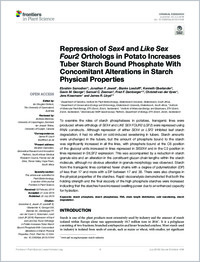Repression of Sex4 and Like Sex Four2 Orthologs in Potato Increases Tuber Starch Bound Phosphate With Concomitant Alterations in Starch Physical Properties.
- Samodien E Department of Genetics, Institute for Plant Biotechnology, Stellenbosch University, Stellenbosch, South Africa.
- Jewell JF Department of Genetics, Institute for Plant Biotechnology, Stellenbosch University, Stellenbosch, South Africa.
- Loedolff B Department of Genetics, Institute for Plant Biotechnology, Stellenbosch University, Stellenbosch, South Africa.
- Oberlander K Department of Conservation Ecology and Entomology, Stellenbosch University, Stellenbosch, South Africa.
- George GM Institute of Molecular Plant Biology, ETH Zürich, Zürich, Switzerland.
- Zeeman SC Institute of Molecular Plant Biology, ETH Zürich, Zürich, Switzerland.
- Damberger FF Institute of Molecular Biology and Biophysics, ETH Zürich, Zürich, Switzerland.
- van der Vyver C Department of Genetics, Institute for Plant Biotechnology, Stellenbosch University, Stellenbosch, South Africa.
- Kossmann J Department of Genetics, Institute for Plant Biotechnology, Stellenbosch University, Stellenbosch, South Africa.
- Lloyd JR Department of Genetics, Institute for Plant Biotechnology, Stellenbosch University, Stellenbosch, South Africa.
- 2018-08-08
Published in:
- Frontiers in plant science. - 2018
RVA
chain length distribution
cold sweetening
starch degradation
starch phosphatase
starch phosphate
English
To examine the roles of starch phosphatases in potatoes, transgenic lines were produced where orthologs of SEX4 and LIKE SEX FOUR2 (LSF2) were repressed using RNAi constructs. Although repression of either SEX4 or LSF2 inhibited leaf starch degradation, it had no effect on cold-induced sweetening in tubers. Starch amounts were unchanged in the tubers, but the amount of phosphate bound to the starch was significantly increased in all the lines, with phosphate bound at the C6 position of the glucosyl units increased in lines repressed in StSEX4 and in the C3 position in lines repressed in StLSF2 expression. This was accompanied by a reduction in starch granule size and an alteration in the constituent glucan chain lengths within the starch molecule, although no obvious alteration in granule morphology was observed. Starch from the transgenic lines contained fewer chains with a degree of polymerization (DP) of less than 17 and more with a DP between 17 and 38. There were also changes in the physical properties of the starches. Rapid viscoanalysis demonstrated that both the holding strength and the final viscosity of the high phosphate starches were increased indicating that the starches have increased swelling power due to an enhanced capacity for hydration.
- Language
-
- English
- Open access status
- gold
- Identifiers
-
- DOI 10.3389/fpls.2018.01044
- PMID 30083175
- Persistent URL
- https://folia.unifr.ch/global/documents/78710
Statistics
Document views: 38
File downloads:
- fulltext.pdf: 0
